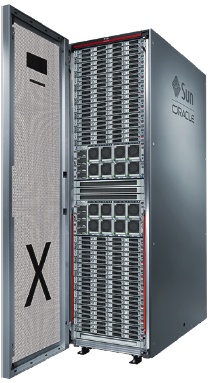Oracle Exadata Database Machine Optimized
Up to 672TB on HDDs and 44TB of PCIe flash per rack
This is a Press Release edited by StorageNewsletter.com on July 22, 2014 at 2:52 pmNews Summary
- Supporting large database workloads used to require large numbers of high-end servers and storage arrays. Now, with Oracle Corp.‘s new Exadata Database Machine X4-8, workloads that previously required dozens of racks of equipment can run faster on a single engineered system.
- It delivers extreme compute and data throughput for large database workloads using 8-socket database servers, intelligent storage, PCI flash cards, and unified IB connectivity.
- While it excels at traditional database workloads such as OLTP and data warehousing, it is optimized for a new generation of workloads: database as a service (DBaaS) and database in-memory. With up to 12TB of DRAM memory, it can consolidate hundreds of databases and can run massive databases entirely in-memory.
Exadata Database Machine X4-8 has been enhanced with increased compute, memory, and communication to provide a platform for customers’ critical data-intensive operations, including data warehousing, OLTP, and big data analytics. The new engineered system is specifically optimized for DBaaS and in-memory database.
Optimized for Oracle Database In-Memory, it supports in-memory processing with massive DRAM capacity, together with transparent data tiering to flash and disk for less performance-critical data.
It supports Oracle Database In-Memory fault tolerance, allowing in-memory processing to continue without interruption, even when a database node fails.
It further reduces the operational and management costs in large private and public cloud deployments of Oracle Database, enabling large-scale DBaaS or consolidation initiatives within the enterprise.
For the database compute nodes, it uses the Xeon E7-8895 v2, an optimized 15-core microprocessor that elastically scales frequency and number of active cores to help deliver peak workload performance.
Overall, it provides large performance and memory increases compared to the previous generation.
Hardware enhancements include:
- 50% more database compute cores, using the Xeon E7 v2 15-core processors
- Up to 6TB of memory per compute node for a total of 12TB per rack
- 2x faster IB with a new PCIe card with all ports active
- Nearly 2x more local disk space
- Up to 672TB of disk storage, and 44TB of PCIe flash per rack
Exadata Database Machine X4-8 hardware is compatible and interoperable with previously released Exadata Database Machines, enabling customers with existing systems to easily expand with the newest system. Additionally, the new software supports previous-generation Exadata hardware systems and also supports both Oracle Database 12c and Database 11g Release 2.
Oracle designs engineered systems to reduce the cost and complexity of IT infrastructure by optimizing performance at every layer of the stack. Thousands of customers worldwide rely on Exadata to simplify data center operations, drive down costs, and accelerate business innovation.
“Since Oracle Exadata Database Machine was introduced in 2008, Oracle has been delivering industry-leading engineered systems that help our customers attain the most value from their enterprise data,” said Juan Loaiza, SVP, systems technology, Oracle. “Exadata Database Machine X4-8 again raises the bar and provides an ideal platform for Oracle Database In-Memory. Together, the combination enables customers to evolve into real-time enterprises.“
“The massive influx of data and the need to respond immediately to changing business conditions require IT to take a new approach to their data infrastructure,” said Diane Bryant, SVP and GM, Intel Corp.‘s data center group. “This customized version of the Intel Xeon processor E7 v2, developed in collaboration with Oracle, helps maximize the power of the Exadata Database Machine X4-8 by elastically accelerating peak performance of database operations, while also reducing the data footprint.“














 Subscribe to our free daily newsletter
Subscribe to our free daily newsletter

